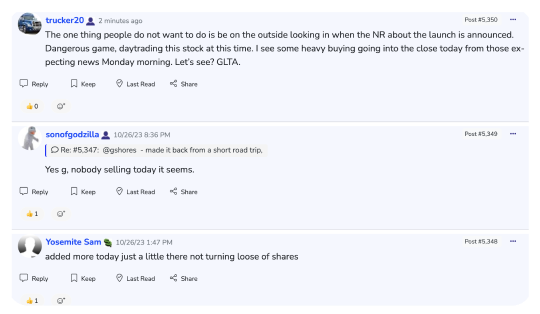Thursday, July 14, 2016 10:55:14 PM
The following is an OCR and may contain some errors, but it makes my point. Personal service robots such as the CareBot are gated by navigation issues. (See bold text.) Baxter is gated by navigation issues with the arms. This is probably why Market and Markets continues to list GOSY's tech in their reports. No one else can do it.
Towards Coexistence of Human and Robot: How Ubiquitous Computing Can Contribute?
Jingyuan Chengl, Xiaoping Chen’, and Paul Lukowiczl
' German Research Center for Arti?cial Intelligence (DFKI),
'Ii'ippstadter Strae 122, D-67663, Kaiseislautern, Germany
2 Multi-Agent Systems Lab, University of Science and Technology of China,
.]inzhai Road 96, Hefei, 230026, China
Abstract. After the ISO 10218-1 / 2 in 2011, safety factors for industry
robot are standardized. As robotics expands its area from industry fur-
ther into service, educational, healthcare and etc., both human and robot
are exposed to a space with more openness and less certainty. Because
there is no common safety speci?cation, we raise in this paper our own
hypotheses on the safety requirements in dense human-robot co-existing
scenarios and focus more on demonstrating the possibilities provided by
the research ?eld named Ubiquitous Computing.
1 Introduction
The number of robots over the world keeps on growing. According to the World
Robotics studies [1], 159,346 units of industry robots were sold in 2013, 16,067
professional service robots and about 3,000,000 personal and domestic use robots
were sold in 2012. As robots’ population grows, the physical even emotional con-
tacts between robots and human are also growing, freeing human from certain
labor work and meanwhile bringing potential risks. As in early ages robots
were implemented mainly in industry, safety speci?cations have been (level-
oped mainly for industrial robots, e.g. ISO 10218-1 /222011 sets the rule on both
robot itself, the robot system and integration [2] [B]; in US the under revision
ANSI/RIA R.l-5.06-2012 re-opens the allowance of human and robot working in
a loop. In industry, the general trend shifts from strict isolation of robot from
human to detailed speci?cations on reducing hazards. Out side of industry, how-
ever, robots are already in close contact with human, especially in the case of
service robot. Since there is no ?xed global speci?cation till now, researchers fol-
low their own ideas on whether and how to separate robot from public audience
at Expo’s and demonstrations. Domestic-use robot providers take care of human
by hiding rigid components inside, reducing the robot’s weight and speed, and
implementing obstacle detecting sensors.
Ubiquitous computing as a fast developing ?eld focuses on pushing the one
central powerful computer to multiple little computing units into the environ-
ment and onto human beings. This indicates tiny sensing al1d processing units,
and naturally, the application ?eld of environment and human activity monitor-
ing, which are also important factors a robot might need, when comes to dense
contact with human beings.
Hazards in Dense Human-Robot Co-existing Scenarios
Vasic and etc. gave a detailed survey on safety issues in human-robot interac-
tions Starting from industry, the danger comes when human gets trapped
between robot and an object (e.g. a wall) or when human cronies into collision
with a robot A detailed list of signi?cant hazards can be found in ISO 10218-1
as annex, including: Mechanical, electrical, thermal, noise, vibration, radiation,
material /substance, ergonomic, the hazards associated with environment and
combined hazards. The hazard should be analyzed and minimized from techni-
cal points of view, however, in the real applications, there are still unexpected
errors and failures which can not be exactly predicted:
— mechanics failure: aging of motors, connectors;
— electronics failure: aging of components and isolation material, out of power
half the way of operation;
— program failure: program hugs, untested scenarios;
— operational error: untrained engineers, operators, and users;
Besides regular maintenance, the above listed hazards are minimized in in-
dustry applications by:
— strictly pre-de?ned environment and space (robot cell);
— strictly pre-de?ned operation routine;
— authorization of properly trained operators, maintenance workers and pro-
gramers;
— speed limitation when human is present;
— protective stop function and an independent emergency stop function.
While robot go out to factory and into family or other social areas, the above
conventional rules become invalid. The situation is similar to that of computer
going from military use to civil and then personal use. The difference is however
the actuation, the capability of active physical movement brings more potential
hazards. Moreover, the robot enters an open environment where changes may
happen anytime and anyhow, the users are most often non-professional and
unexperienced people. Animals (e.g. pets) might come into close contact with
the robot, which might even bring damage to robot. (e.g. a child might see a
home service robot and pour water onto it just out of curiosity.) Due to these
obstacles, the most sold service robot now is still household robots, which are
small in size, carry out comparatively simple and ?xed tasks.
link.springer.com/chapter/10.1007/978-3-319-16841-8_39
| Volume: | 1,200 |
| Day Range: | 0.0001 - 0.0001 |
| Bid: | |
| Ask: | |
| Last Trade Time: | 11:20:55 AM EDT |
| Total Trades: | 1 |
Wytec Prepares for 1st AI Gunshot Detection Pilot • WYTC • Apr 4, 2025 7:09 AM
ConnectM Receives $1.60 Per Share Buyout Offer from its Three Largest Institutional Investors • CNTM • Apr 2, 2025 9:00 AM
Nightfood Holdings Completes Acquisition of Carryout Supplies, Deepening Vertical Integration in AI-Powered Hospitality Automation • NGTF • Apr 2, 2025 8:30 AM
Avant Technologies Partner, Ainnova, to Sponsor and Present at 2025 Healthcare Innovation Summit in Mexico City • AVAI • Apr 2, 2025 8:00 AM
Glidelogic Corp. Unveils ResearchMind - Pioneering AI-Driven Research Innovation for a Global Academic Community • GDLG • Apr 1, 2025 2:10 PM
Fifty 1 Labs, Inc. Celebrates Groundbreaking SpaceX, NASA, and ISS Yeast Experiment by Subsidiary Genetic Networks • FITY • Apr 1, 2025 9:30 AM









